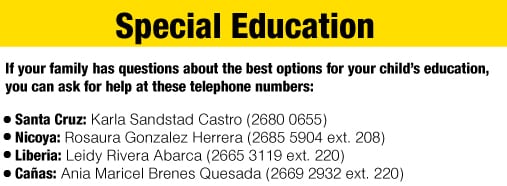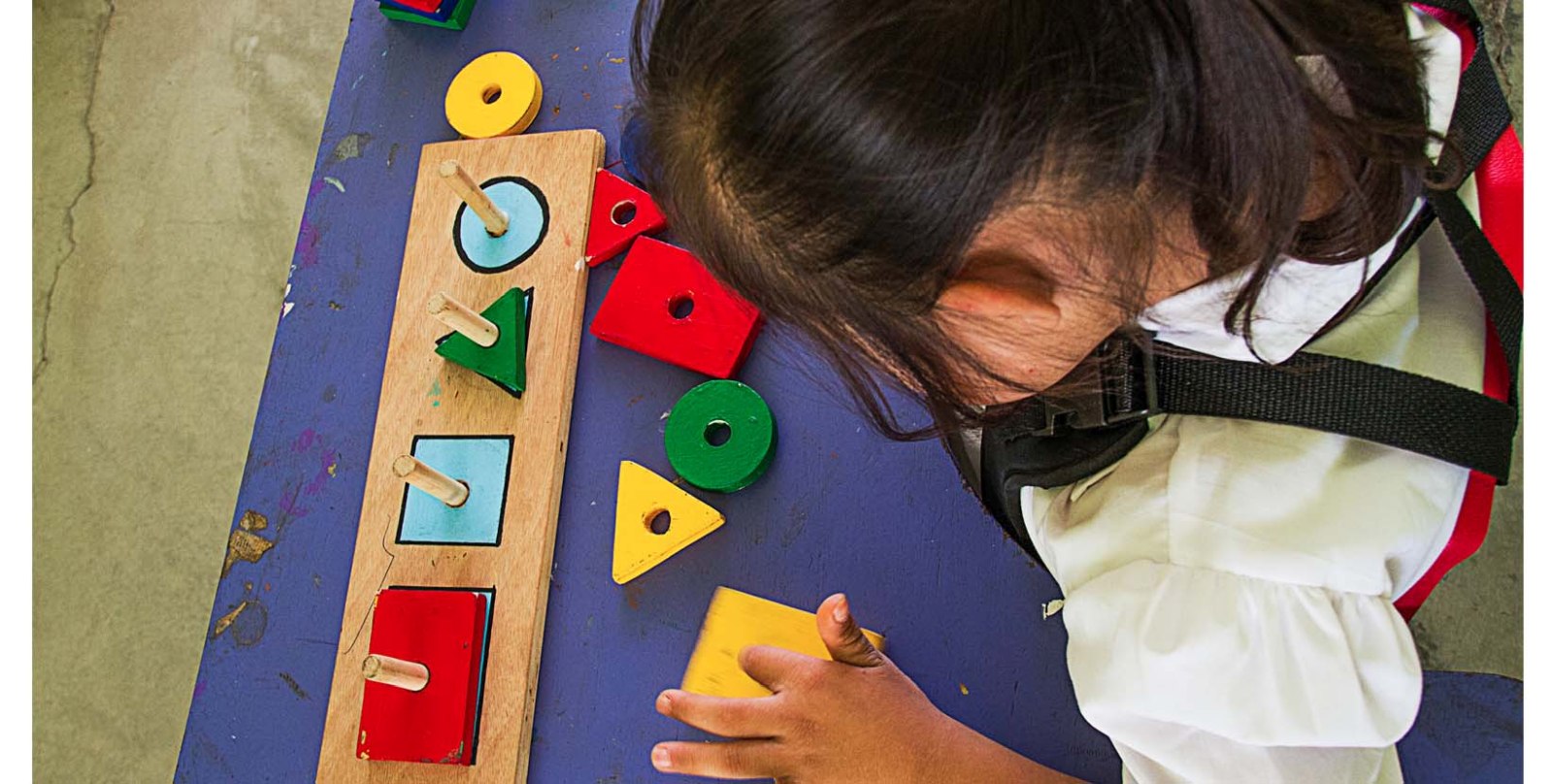
It’s past 9 a.m. and the Nosara sun scorches the property known as El Capulín. In the distance, Maricela Martínez comes walking with her 6-year-old son Feison in her arms. The boy’s feet dangle a foot-and-a-half off the ground. He weighs around 55 pounds.
He can’t walk because he was diagnosed with cerebral palsy when he was born. Another 35,647 people in the province live like him with at least one disability.
When he’s not in her arms, Feison uses a special wheelchair. He tries to maneuver it, but most of the time it’s Martínez who pushes him around the town’s rocky streets. Fortunately, he doesn’t live far from the Santa Marta School of Nosara where he studies.
But in Nosara, like so many other districts and communities that are far from Guanacaste’s urban centers, education for children with disabilities is far from a right guaranteed by the state.
And it’s not because the schools deny them space, but because reaching them, at least those that offer a more comprehensive and specialized education, is the first obstacle to overcome, followed by the hurdle of poverty.
A Single Class
Feison has attended a regular classroom at the Santa Marta School for two years. Most of the time “they make him draw pictures,” says Martínez.
His lessons are rarely longer than three hours. Feison’s 9-year-old sister Yensy goes to class for at least five hours and comes home with homework and notebooks full of material.
The principal of the school Geishi Jiménez explains that they do everything they can with the resources and personnel that they have.
“Feison shares the classroom with 20 other children that are already learning to read,” Jiménez says. “He’s on another level. It’s difficult for us. The mothers of special children must understand that they are special needs kids and they can’t go at the same pace as the rest.”
According to Martínez, if Feison wants a better education she would have to take him to the central district of Nicoya, 45 kilometers from her home. There he would receive “good” lessons.
The Leonidas Briceño School in Nicoya is the only school available among the cantons of Hojancha, Nandayure and Nicoya with a preschool classroom equipped for special education. And that, according to Feison’s mother, is the education that he needs.
The Costa Rican Ministry of Public Education (MEP) admits that 85 percent of students with disabilities between the age of 4 and 6 – and 63 percent of those under age 4 – are at risk of missing out on this stage of their infancy in which the nervous system has the greatest possibility to compensate for alterations in the body and mobility.
Currently, the classroom at Leonidas Briceño receives 32 students from three cantons.




A Single Center
Out of the country’s 24 special education centers, only one is located in the province of Guanacaste.
The ministry defines special education centers as spaces exclusively for people through the age of 21, who, because of their disability, require more intense services such as physical therapy or occupational therapy. These services aren’t usually offered in conventional education centers.
The fifth Report of the State of Education from 2015 criticizes how some students must travel long distances in order to receive services that are offered in those learning centers. This especially disfavors the youngest students.
The document points out how provinces outside the metropolitan area lack specialized centers for children with specific disabilities such as blindness.
“The metropolitan area is the only part of the country that has institutions specialized in attention to a specific type of disability,” the report says. “For example, the Fernando Centeno Güell National Special Education Center includes three departments: mentally retarded, visual deficiencies and audial and language.”
The ministry assures that the limited quantity of special education centers is compensated by the attention students receive through integrated classrooms, as well as visits from traveling special education teachers who attend to special needs children in regular classrooms.
But in the case of the Santa Marta School, the principal says this extra classroom support only comes once a week on Fridays. In her eyes, that’s not enough.
“I’m going to request that they assign us a permanent special education professor for the school next year, one that can help the children from Monday to Friday,” Jiménez says.
For Total Inclusion
For MEP, the discussion isn’t about whether a child with disabilities receives education in a standard school or specialized space, but rather that the country must start including them in regular classrooms. More inclusion comes on the recommendation of the United Nations.
In March 2018 the government signed a decree that requires institutions to incorporate children and youth with disabilities into regular classrooms alongside other schoolchildren.
As a result, the ministry has 10 years to slowly transform classrooms into inclusive spaces with support for learning disabilities.
This new rule doesn’t convince everyone.
“I feel that the teachers don’t know what to do with him in a classroom that is shared with the other children,” says Feison’s mother.
School principals like Jiménez allege that they are just now learning how to eliminate the gaps between children with disabilities and others that attend regular classrooms.
Jiménez explains that they lack personnel and that the system is rigid.
“MEP should train us better,” she argues. “They give us the responsibility of attending to every type of child and we don’t have a way to do that. If a child with blindness enrolls, I can’t deny him an education, but how do I do it?”
The head of MEP’s Department of Special Education Gilda Aguilar recognizes some resistance to changing the system.
“If you talk to the families of a child with a disability, they think that this inclusion isn’t beneficial,” says Aguilar. “That the children need more attention and that including them with the rest of the children shouldn’t happen. Experience has taught us that when the spaces are less restricted, these kids are better at reaching their potential.”
“It’s a myth that they are going to receive less attention,” she continues. “Children need to socialize because that’s how the world is. Kids need independence and self-determination.”

Children that live with a disability in the province have difficulties finding satisfactory education, according to their mothers and teachers. In this photo, Selena helps her sister Kahory wiht her schoolwork.
Drops of Assistance
Finding the optimum education for a child with disabilities can also present a significant cost for some families.
Martínez says she used to take Feison to Nicoya so he could receive “the education he needed,” but the trip was overwhelming for both of them. Between needing to take Feison on a stretcher the whole way and the cost of the trip itself, she had to quit.
“I would spend ¢8,000 ($14.15) per person for the trip. Multiply that by three days a week that they recommended taking him,” she says. “I can’t afford that. I don’t work and we barely have enough to cover our needs with the jobs that my partner does.”
According to data from the 2011 census by the National Statistics and Census Institute (INEC), poverty continues to be a characteristic strictly linked to disability. Nationally, 31.5 percent of people with at least one disability live in poverty.
Both MEP and the state have tried, on paper, to fight this problem. School cafeterias, student transportation, scholarships from the National Scholarship Fund (Fonabe) and subsidies from Avancemos are all included in the equality programs that MEP manages.
But the help dissipates among families that don’t know they have access to these resources, and among those who receive it without needing it.
The fifth Report of the State of Education points out how resources for the student transportation subsidies program increased 150 percent in 2014, while beneficiaries of the program only rose 57 percent.
On the other hand, Warner Matarrita, principal at Leonidas Briceño School, said that while the scholarships take a long time to arrive, they eventually do.
“We have 43 students at Leonidas Briceño with disabilities who we get transportation grants for. We give the money to the father of the family and the father finds the best option,” he says. “The amount varies. It could be as much as ¢50,200 ($89) per month depending on the distance.”
Martínez says Feison doesn’t receive any grants from the government. They applied for a transportation grant and were rejected. Now they are applying for assistance from the Social Security Institute (CCSS) that Feison is entitled to for his disability.
But this is a discussion for adults. Children don’t know about the quantity of education centers or how many teachers come and go. Children already practice the inclusion that MEP so badly wants to realize.
Feison has a special swing at school that allows him to balance in his seat. His own classmates give him the pushes he needs to soar a little off the ground.







Comments